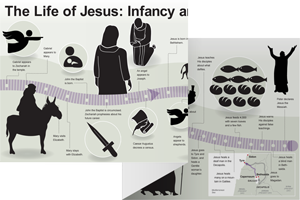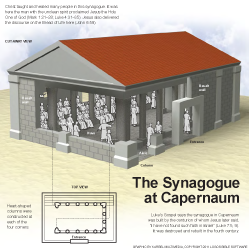2:1–12 Beginning in ch. 2, John presents a series of signs or miracles designed to prove Jesus’ identity as the Messiah and Son of God. In this first sign, Jesus turns water into wine at a wedding in Cana attended by His family and disciples. |
 Miracles of Jesus Table
Miracles of Jesus Table
2:1 the third day John is narrating the events of the first week of Jesus’ ministry. This is two days after the call of Philip and Nathanael (1:43–51).
Cana in Galilee A village in central Galilee, nine miles north of Nazareth. According to 21:2, Cana was Nathanael’s hometown.
mother of Jesus Mary (Matt 1:18). John never uses her name in his Gospel.
2:3 the wine An essential part of the diet in the ancient world. Drinking wine symbolized peace and prosperity (see Psa 104:15), but excessive drinking and drunkenness were condemned (see Prov 20:1).
ran out The host was responsible for providing wine throughout the wedding feast, which typically lasted seven days.
 Water into Wine: The Social Impact of Jesus’ Miracle at Cana
Water into Wine: The Social Impact of Jesus’ Miracle at Cana
2:4 What does your concern have to do with me The Greek text here literally reads, “what is that to me and you?” Jesus is likely petitioning His mother to consider whether the request is really the type of thing He should be addressing with His power; He probably wants her to consider His purpose.
woman A typical means of addressing a woman in John’s Gospel (John 4:21; 19:26; 20:13). This usage is not disrespectful, but a simple, informal form of address.
 The Role of Women in John’s Gospel
The Role of Women in John’s Gospel
2:5 Whatever he says to you Mary did not take Jesus’ refusal as a firm negative response and clearly did not understand it as a rebuke. She knew Jesus was able to take care of the problem.
2:6 six stone water jars Large stone pots were used for storing water for ritual purification. Examples have been unearthed in Palestine from this period. The jars were cut from single blocks of stone; stone was used because it did not convey ritual impurity.
from this period. The jars were cut from single blocks of stone; stone was used because it did not convey ritual impurity.
ceremonial cleansing of the Jews For an audience unfamiliar with Jewish practice, John explains the purpose of the jars. Ritual handwashing before and after a meal is part of later Jewish teaching.
two or three measures All six jars would have held 120–180 gallons. Large quantities of water were needed for ritual purification.
2:7 they filled them to the brim Making it impossible for the miracle to have been a deception. The use of the jars for a purpose other than ritual purification would have rendered the jars temporarily unclean and unusable for ritual purposes.
and unusable for ritual purposes.
2:8 head steward This phrase denotes an honorary position, a person primarily tasked with regulating the distribution of the wine. Compare the deuterocanonical work Sirach 32:1–2.
2:10 Everyone serves the good wine first Over the course of a feast, diluting wine with water was a common practice to make it go further. As the week progressed, the guests would have been less attuned to the decreasing quality of the beverage.
whenever they are drunk While drunkenness was common for Greek banquets, it was not an approved practice for Jewish feasts. All types of wine in ancient Palestine were alcoholic, however.
2:11 beginning of signs The signs are designed to reveal Jesus’ identity as the Messiah. John declares that his purpose in writing the Gospel was to promote belief through the story of Jesus and the signs He performed (John 20:30–31).
Miracles Unique to John’s Gospel | ||
Water into Wine, 2:1–11 | Official’s Son Healed, 4:46–52 | Paralytic Healed, 5:1–13 |
Blind Man Healed, 9:1–12 | Lazarus Raised from the Dead, 11:38–44 | Miraculous Catch of Fish, 21:1–14 |
2:12 Capernaum A town on the northwest shore of the Sea of Galilee where Jesus based His ministry (Matt 4:13; Mark 2:1).
on the northwest shore of the Sea of Galilee where Jesus based His ministry (Matt 4:13; Mark 2:1).
2:13–25 Jesus and His disciples travel to Jerusalem to observe the Passover. While there, Jesus drives those conducting business for profit out of the temple courts for violating the sanctity of the site. He also performs more miracles while in Jerusalem. |
Israelite Festivals in John’s Gospel | |
Passover (3 different years) | |
An unnamed festival | |
Festival of Tabernacles | |
Festival of Dedication (Hanukkah) | |
2:13 Passover of the Jews One of the three pilgrimage festivals during which all Jews were to travel to Jerusalem to worship at the temple (Exod 12:1–28).
 Israelite Festivals Table
Israelite Festivals Table
2:14–22 All four Gospels contain an account of the cleansing of the temple (Matt 21:12–13; Mark 11:15–17; Luke 19:45–46), but John’s is the most detailed. John mentions the trade in oxen and sheep as well as doves, and he adds the detail of Jesus fashioning the whip of cords used to drive out the animals. John also records a command not found in the other accounts (John 2:16). However, John does not allude to the two Scripture passages (Isa 56:7; Jer 7:11) used by Jesus to justify His actions in the Synoptic Gospels (Matthew, Mark, and Luke). The disciples apply Psa 69:9 to Jesus’ action in John 2:17. |
2:14 temple courts The temple complex had been greatly expanded by Herod the Great in the late first century bc, and work continued into the mid-first century ad.
oxen and sheep and doves People who had traveled from a great distance for the festival could hardly have brought their sacrificial offerings with them; traders took advantage of that by selling animals for sacrifice in the outer courts. People likely paid exorbitant prices for the convenience of buying at the temple.
2:15 made a whip of cords Used for driving out the large animals. See note on vv. 14–22.
2:16 the doves Pigeons or doves were the offerings of the poor (Lev 5:7).
Take these things away from here This commandment in unique to John’s Gospel.
my Father’s house a marketplace Turning the outer courts into a market effectively prevented worship for non-Jewish people. Jesus’ quotation of Isa 56:7 in the Synoptics underscores His desire for the temple to be a “house of prayer for all peoples.” Jesus is angered by the commercialization of temple worship, which created an obstacle to true worship.
2:17 Zeal for your house will consume me The disciples remembered Psa 69:9 and applied its image of the righteous sufferer to Jesus. Some around this time expected the Messiah to purge Jerusalem of unbelievers (Psalms of Solomon 17:21–24). Jesus is concerned with believers’ (at least supposed believers’) condition before God as well. With this act, Jesus declares the current state of the temple to fall vastly short of God’s plan for it; the worship of God is being impeded by commerce.
 Jesus’ Fulfillment of Old Testament Prophecy Table
Jesus’ Fulfillment of Old Testament Prophecy Table
2:18 the Jews Referring to the religious leaders in the temple. See note on John 1:19.
sign As they had with John the Baptist, the religious leaders want Jesus to justify His actions. See note on 1:25.
2:19 in three days I will raise it Foreshadows Jesus’ death and resurrection.
2:20 forty-six years The renovations and expansion begun by Herod the Great were still underway. Compare note on v. 14.
2:21 speaking about the temple of his body The use of misunderstanding is a prominent part of John’s style. He regularly records Jesus’ hearers misunderstanding His sayings, sometimes requiring further elaboration as in the case of Nicodemus (John 3:1–10).
2:24 entrust The Greek text uses the word pisteuō here. John uses a wordplay here, describing how “many believed” (pisteuō in Greek) in Jesus in v. 23, but Jesus does not trust or believe (pisteuō) them in return.
2:25 did not need anyone to testify about man Jesus is divinely appointed, so the glory of other people is not His concern—He receives His glory from God the Father. This verse provides the transition to Jesus’ encounter with Nicodemus and prepares the reader for Jesus’ divine insight into Nicodemus’ spiritual needs.

|
About Faithlife Study BibleFaithlife Study Bible (FSB) is your guide to the ancient world of the Old and New Testaments, with study notes and articles that draw from a wide range of academic research. FSB helps you learn how to think about interpretation methods and issues so that you can gain a deeper understanding of the text. |
| Copyright |
Copyright 2012 Logos Bible Software. |
| Support Info | fsb |
 Loading…
Loading…






